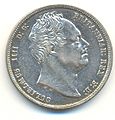Princess Charlotte of Clarence facts for kids
Quick facts for kids Charlotte of Clarence |
|
|---|---|
| Born | 27 March 1819 Hanover |
| Died | 27 March 1819 |
| Burial | St George's Chapel in Windsor Castle |
| House | House of Hanover |
| Father | William IV |
| Mother | Adelaide of Saxe-Meiningen |
Princess Charlotte of Clarence was a royal baby born on March 27, 1819, in Hanover. Sadly, she passed away on the very same day she was born. She was the first child of William IV of the United Kingdom, who would later become King, and his wife, Adelaide of Saxe-Meiningen.
A Royal Baby
Charlotte was the oldest daughter of Prince William, who was then the Duke of Clarence, and Princess Adelaide. Her birth was a significant event for the royal family. Even though she lived for only a short time, she was an important part of the royal line.
Her Family
Princess Charlotte had four younger siblings, but none of them survived to adulthood. Her sister, Elizabeth of Clarence, also passed away when she was very young. Her parents also had two stillborn brothers and another stillborn sibling. This meant that none of William IV and Queen Adelaide's children lived to become adults.
Images for kids
-
William aged thirteen (left) and his younger brother Edward, painted by Benjamin West, 1778
-
William in dress uniform painted by Sir Martin Archer Shee, c.1800
-
Cartoon by James Gillray of William and Mrs. Jordan: A large, cracked chamber-pot represents Mrs. Jordan, and the Duke has thrust himself into a fissure in the 'Jordan'.
-
Mrs. Jordan in the Character of Hypolita, mezzotint by John Jones of London, 1791, after a painting by John Hoppner
-
"The Disconsolate Sailor", 1811: a cartoon by Charles Williams about Catherine Tylney-Long's choice between the Duke of Clarence (right) and William Wesley-Pole (left)
-
Adelaide of Saxe-Meiningen by Sir William Beechey, c. 1831
-
William IV in Masonic insignia. Portrait by James Lonsdale, 1830
-
Political cartoon supporting the Reform Act: King William sits above the clouds, surrounded by Whig politicians; below Britannia and the British Lion cause the Tories to flee.
-
Portrait by Sir David Wilkie, 1837
-
Half-Crown of William IV, 1836. The inscription reads GULIELMUS IIII D(EI) G(RATIA) BRITANNIAR(UM) REX F(IDEI) D(EFENSOR) (William IV by the Grace of God King of the Britains, Defender of the Faith)














